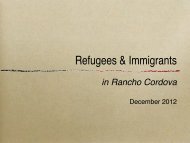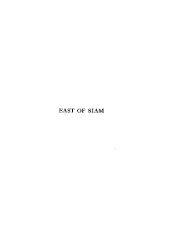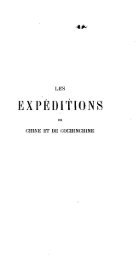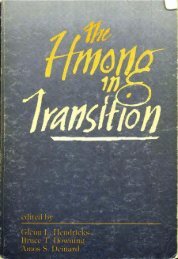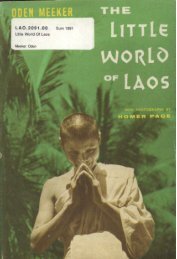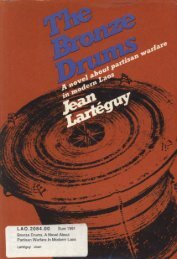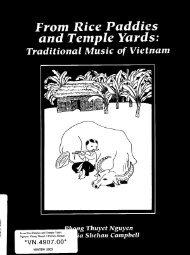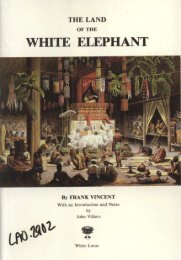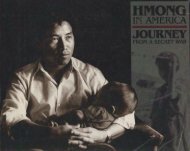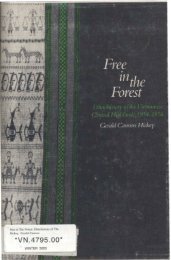PEOPLE
Grant, The Boat People - Refugee Educators' Network
Grant, The Boat People - Refugee Educators' Network
- No tags were found...
Create successful ePaper yourself
Turn your PDF publications into a flip-book with our unique Google optimized e-Paper software.
The Bwt hpL<br />
future, Hc was twenty-three and a trained computer programma:<br />
Soon he would leave to join an uncle in the United States. Some<br />
Bidong residents had been there for ten months and had still not<br />
qualified for resettlement.<br />
Mr Choy told his story overlooking the 'front beach: one of<br />
Bidong's moat coveted - and cxpensive - residential areas because<br />
it was close to the market, sdminimative centre, water and ratioq<br />
distribution points and such other modest facilities as the island had.<br />
Behind him lay a warren of shanties, some three storeys high. The<br />
main beams of these houses were of hand-hewn timkr from the hill.<br />
Uppcr rooms had slat flwn. The walls were made of cardboard, tin,<br />
bark and timber; the roofs of blue plastic sheeting or bone-coloured,<br />
waterproof sack8 that once contained e popular brand of Malayaim<br />
sugar. An average m m was about three by two metres, in which<br />
several fmmilies might crowd to sleep at night. The well-to-do on<br />
Bidong - those who managed to bring some valuables onto the island<br />
or who had made money since ariiving - lived less congested home<br />
lives. Some even had lights drawing electricity from car batteries. .<br />
The beach was fouled with heaps of rubbish rotting in the heat<br />
and humidity, At one end near the jetty an incinerator was nearing<br />
completion. Flies swarmed everywhere and the stench of hummn<br />
excrement was oppressive, At the end of the btach furthest from the<br />
camp centre, figures squatred on rocks defecating into the water.<br />
Nearby, other rtfugecs were fashioning a crude screen around the<br />
hulk of a nventy-metre boat lying in the shallows: it was destined<br />
to sene as a temporary I~trinc. 'We face many dileulties,' said<br />
Father Le Ngoc Trieu, former president of the Catholic education<br />
board in south Vietnam. 'We have run out of space to bury rubbish,<br />
We had to fill in some of the old latrine pits to build more houscs<br />
over them!<br />
Shortage of water for drinking and cooking was acute. A crowd<br />
of children gathed around a well 'fishing' for water from a meagre<br />
pool at the bottom. Of 120 wells, only about 20 were still in use.<br />
'The rest were polluted or dry. Weather permitting, r barge ferried ,<br />
water to the island from Kuala Trtngganu every couple of days,<br />
Since the start of the dry season, quotas had been cut from five litrts<br />
to two lim ptr person per day. A pair of water storage tanks were<br />
being built on the front beach and abut a hundred fibreglass con-<br />
tainers lay there awaiting installation, In the meantime the queues<br />
for water were long. Tempers flared and fights sometimes broke out<br />
as patience dried up under the burning sun.<br />
Dr Nguyen Van Quoc, aged rhirry, was one of eighty doctors,<br />
twenty pharmacists and twelve nurses in Bidong's refugee population.<br />
They staffed a tin-roofed clinic in the centre of the camp.<br />
Therc had been 371 births on the island and 78 deaths. Tht babies<br />
were born on a slightly inclined tabletop wirh a pale-blue plastic<br />
rubbish tin at its foot to catch the natal fluids and the afterbirth<br />
waste. Sornc of the deaths could easily have been prevented. I am<br />
afraid we do not have enough medicines. We uat what we fan get,<br />
We need more antibiotics, vimin pills and drugs for treating<br />
asthma and tuberculosis,' mid Dr Quoc. Early in 1979 a bout of<br />
infectious hcparitisl struck about 500 refugees, Isoiated cases of<br />
meningitis and typhoid, but fortunately no cholera, had also<br />
occurred. There wtrt rwenty-eight cases of mental illness, most of<br />
them 'RPM' piracy victims. One was a young boy who had wrtchcd<br />
his father die at sea.<br />
Deaths generally fell into TWO eatcgories: the old and the young.<br />
Dr Quoe said malnutrition among children in the camp was common.<br />
'The diet is not adcqu~tc for children. There are not enough<br />
vitamins and prowins in the food they get. Their resistance to illness<br />
drops. That can be fatal! For babies, the diet was potentially lethal.<br />
For more than a month, refugee architeas and arpcnm had k n<br />
working sixteen hours a day in two shifts to finish a new woodm<br />
hospiral kforc the deprture of the French ship Iris & LumGn<br />
which had heen serving as a floating hospital for serious cases.<br />
Thc UNHCR'S<br />
standard ration pack contained 900 grams of rice,<br />
a tin of condensed milk, three tins of canned meat, fish and vegetables,<br />
two packets of noodles, sugar, salt and two smll tcabags.<br />
One pack was distributed to each person over the age of three and<br />
had to last for three days. Children under three got milk powder and<br />
dry biscuits. Fresh vegetables were officially available only every six<br />
weeks or two months.<br />
The monotony of thif; diet - and of lift itself - on Bidol~g was<br />
cclieved by a booming black market. The island was a monument<br />
to entrepreneurial talent. Tailors, barbers, mechanics, pawnbrokers,<br />
bakers, cakemaktrs, and hawkers of all kinds sold heu skills, brawn





